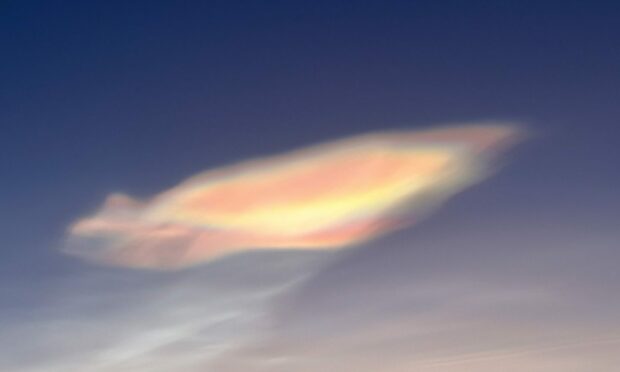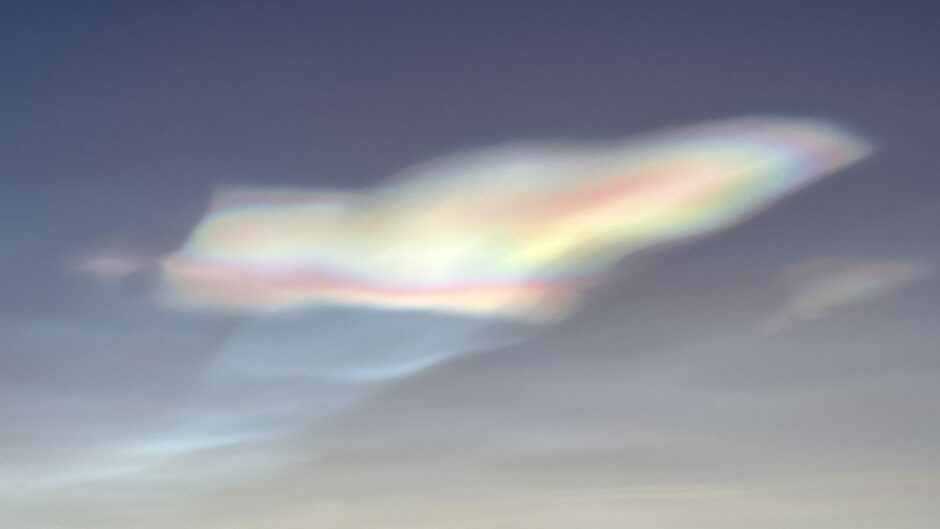A meteorologist has warned that bright and colourful clouds known as “mother of pearls” seen over the north of Scotland mask a darker side.
Eddy “Weather” Graham, an award-winning researcher and lecturer at the Lews Castle College UHI, said they may be stunning to most observers, but he instead sees them as “harbingers of doom”.
The rare polar stratospheric clouds – also known as nacreous clouds because of their “mother of pearl” colour – have been casting an iridescent pastel hue across our skies from Sunday evening into this morning.
But behind the awe-inspiring beauty of these cloud formations, Mr Graham says there is a potential threat to the environment.
Heavenly warning of the damage we are doing?
Mr Graham said: “They may look beautiful but some of them are actually destroying the ozone layer.
“It’s complex chemistry, but the beauty is actually having a destructive effect.
“They’re a real harbinger of doom. Maybe one of the reasons we are seeing more of them is we are having an increasingly greater impact on the environment.”
Nasa says chemical reactions within these rare cloud formations create circumstances that “destroy stratospheric ozone”.
A Nasa blog said: “Since stratospheric ozone blocks harmful, cancer-causing, solar ultraviolet radiation, the thinning of the ozone in both hemispheres threatens the health of both our environment and ourselves.”
“They’re maybe our heavenly warnings,” added Mr Graham.
Here’s what they were like in Norway a few days ago
To say I am pleased with how these Nacreus Clouds came out is an understatement. Just wish I had my proper camera on me. What a treat though when these appeared above my head yesterday when leaving Tromso. @BBCWthrWatchers @CloudAppSoc @chunder10 pic.twitter.com/rXfCBd9RNQ
— Paul Botten (@StatoStorm) January 27, 2023
Why do mother of pearl clouds occur?
Sometimes mistaken for the Northern Lights, the vibrant nacreous clouds form when the temperature is lower than minus 85 degrees Celsius.
They are normally only seen far further north, rarely here, although Mr Graham says research suggests there may be several human factors causing their increasing appearance above Scotland’s skies.
Mr Graham said they collect at a much greater height than our usual clouds, some 40 kilometres (24 miles) higher in the atmosphere, way up in the stratosphere, above the weather layer, which is called the troposphere.
He added: “There are processes which operate to make the stratosphere colder and one of those processes is the mountains, they cause that to happen, that’s why you spot them right over places like Nairn, the Highlands are making them happen.
“The second process is the hole in the ozone layer which we have created. It is repairing itself a little bit but it’s still pretty bad.
“The ozone absorbs sunlight but if you take away a bit of it it can’t warm up as much.”
Global warning is the third process, said Mr Graham.
“One of the counter-intuitive aspects is global warming warms the surface but at the same time it cools the stratosphere, the warmer it gets on the surface of the planet, the colder it gets on the stratosphere.”
Photographs of the mother of pearl clouds all across the north of Scotland
Although they pose a potential risk to the atmosphere, there’s no doubting their beauty, and people were out capturing the mother of pearl clouds all across the north, including Moray.
Taken by Alan C Tough on January 29, 2023 @ Elgin, Moray, #Scotland pic.twitter.com/symwYhUhgj
— Tex (@TexN9ne) January 29, 2023
Peter Stronach, an ecologist and photographer, captured their vibrancy from Alness in Easter Ross, looking towards the yards at Nigg.
He said: “They are surreal, they’re such an incredibly vivid colour for a cloud, and that’s what makes them so unusual.
“Unlike the other clouds on this windy morning, they aren’t moving, they’re just staying still, high up in the sky.
“I’ve only seen them once before a long time ago in Edinburgh, they are so rare.”
Nacreous clouds viewed from Grantown, looking towards Laggan area! pic.twitter.com/pDwYqlHZJZ
— Peter Stronach 🦅🐳🐝🌲 (@macstronach) January 29, 2023
This was coming from Banff to Keith yesterday that I seen it at pic.twitter.com/NNc2qFZcWG
— Kimmie A (@KimmieA18) January 30, 2023












Conversation